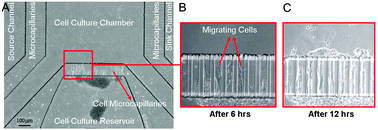Directional migration and differentiation of neural stem cells within three-dimensional microenvironments†
Abstract
Harnessing neural stem cells to repair neuronal damage is a promising potential treatment for neuronal diseases. To enable future therapeutic efficacy, the survival, proliferation, migration and differentiation of neural stem/progenitor cells (NPCs) should be accurately studied and optimized in in vitro platforms before transplanting these cells into the body for treatment purposes. Such studies can determine the appropriate quantities of the biochemical and biomechanical factors needed to control and optimize NPC behavior in vivo. In this study, NPCs were cultured within a microfluidic device while being encapsulated within the collagen matrix. The migration and differentiation of NPCs were studied in response to varying concentrations of nerve growth factor (NGF) and within varying densities of collagen matrices. It was shown that the migration and differentiation of NPCs can be significantly improved by providing the appropriate range of NGF concentrations while encapsulating the cells within the collagen matrix of optimal density. In particular, it was observed that within collagen matrices of intermediate density (0.9 mg ml−1), NPCs have a higher ability to migrate farther and in a collective manner while their differentiation into neurons is significantly higher and the cells can form protrusions and connections with their neighboring cells. Within collagen matrices with higher densities (1.8 mg ml−1), the cells did not migrate significantly as compared to the ones within lower matrix densities; within the matrices with lower collagen densities (0.45 mg ml−1) most of the cells migrated in an individual manner. However, no significant differentiation into neurons was observed for these two cases. It was also found that depending on the collagen matrix density, a minimum concentration of NGF caused a collective migration of NPCs, and a minimum concentration gradient of this factor stimulated the directional navigation of the cells. The results of this study can be implemented in designing platforms appropriate for regeneration of damaged neuronal systems.


 Please wait while we load your content...
Please wait while we load your content...